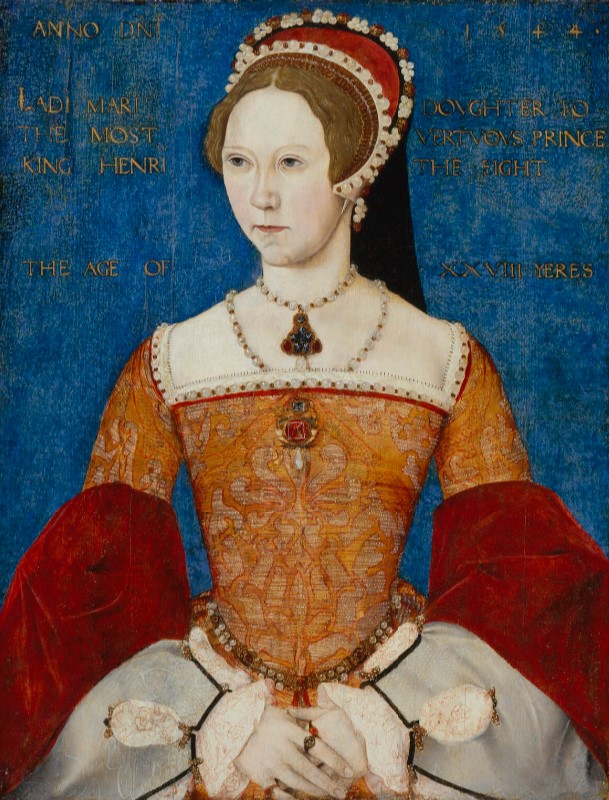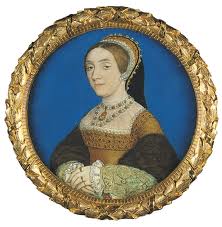
Mary Tudor, Master John, 1544 https://www.npg.org.uk/collections/search/portrait/mw04264/Queen-Mary-I
At that period the great topic of conversation amongst ghost-hunters was Glamis Castle, the most celebrated of all haunted houses. No ghost book is ever considered complete without reference to this celebrated Castle, and the story usually narrated is, that in the secret room some abnormal horror lived, and that the heir, Lord Glamis, and the factor, had to be told of its existence by the Earl of Strathmore in person. This information was of so terrible a nature that it changed not only the lives of those two men, but even their personal appearance. They grew aged and haggard in a single night.
This story was readily discussed in old days by members of the Strathmore family, who were just as keen as outsiders were to probe the mystery. To-day it is universally believed that the monstrosity is at last laid to rest, and that though other ghosts still walk the Castle, the worst has departed forever.
I went one afternoon to see [Lord and Lady] Wynford in the hotel in which they stayed whilst in Scotland, and found Lady [Fanny] Reay with them. She was a wonderful woman in her way, and preserved her youth up till very late in life. Lord Wynford was not present, and Lady Wynford at once greeted me by exclaiming, “We are going to stay at Glamis next week, and Lady Reay has been there and seen a ghost.”
“But not the ghost,” admitted Lady Reay.
“Then what did you see?” I inquired.
She then told the following story, which has a sequel: —
“I had been in the Castle for three nights and much to my satisfaction seen absolutely nothing. We were a very cheery party, and every one was frightfully thrilled and nervously expectant, but we were very careful not to breathe the word ‘ghost’ before our host and hostess.
“On the fourth night I was awakened by a moaning sound in my room, and I opened my eyes. The room was in total darkness, but I saw something very bright near the door. I shut my eyes instantly, and pulled the bedclothes over my head in a paroxysm of fear. I longed to light my candles, but didn’t dare, and the moaning continued, and I thought I should go quite mad.
“At last I ventured to peep out again. I saw a woman dressed exactly like Mary Tudor, in her pictures, and she was wandering round the walls, flinging herself against them, like a bird against the bars of a cage, and beating her hands upon the walls, and all the time she moaned horribly. I’m sure she was the ghost of a mad woman. Her face and form were lit up exactly like a picture thrown upon a magic lantern screen, and every detail of her dress was clearly defined.
“Luckily she never looked at me, or I should have screamed, and I thought of Lord and Lady I. sleeping in the next room to mine, and wondered how I could reach them. I was really too terrified to move, and the ghost kept more or less to that part of the room where the door was situated.
“I must have lain there awake for two or three hours, sometimes with my head buried under the clothes, sometimes peeping out, when at last the moaning suddenly stopped. I opened my eyes. Thank God, I was alone. The ghost had departed.
“I lay with wide open eyes till daybreak. Then the first thing I did was to run to the mirror to see if my hair had turned white. Mercifully it hadn’t, but I looked an awful wreck.
“I told just a few people what I had seen, and contrived to get a wire sent me before lunch. Early in the afternoon I was on the way to Edinburgh.”
Such was the story Lady Reay related.
Thirteen years later Captain Eric Streatfield, who was a nephew of Lord Strathmore, and an intimate friend of my husband, told me exactly the same story. He was a boy of six at the time, when the lady of Tudor days appeared moaning in his room, and he said he would never forget the misery of the night he passed. He was very much interested in hearing that Lady Reay had gone through the same experience.
Ghosts I Have Seen And Other Psychic Experiences, Violet Tweedale, 1919: pp. 165-168
Mrs Daffodil’s Aide-memoire: Tudor lady ghosts were a staple of the Victorian/Edwardian supernatural scene. Mrs Russell-Davies interviewed the ghosts of Catherine Howard and Jane Seymour, while William Waldorf Astor was snubbed by the ghost of Anne Boleyn when he bought Hever Castle.
There were many ghosts at Glamis. This particular moaning ghost might have been the so-called “Tongueless Woman,” sometimes identified as a wronged servant girl and sometimes as a Countess of Strathmore.
The famous, the fierce, and frowning northern stronghold of the Lords Strathmore is Glamis Castle (pronounced Glams), and while it may seem flippant to say so, Glamis has ghosts from ‘way back, from the time of King Duncan and bloody Macbeth, from before the coming over of William the Norman.
The Ghost of Glamis.
Beside them those of Leap are just tricksome brownies Nobody in England but takes Glamis seriously and nobody disputes the existence of some frightful mystery hidden for generations in the dungeons or the secret tower chambers of the brutal looking pile of masonry. Even Dean Stanley acknowledged a feeling for Glamis’ ghost. He wasn’t so sure it was a fake. The dean had a way of digging up the royal folk and others who sleep in Westminster Abbey, just to see if they were all there and doing comfortably, and he was not a nervous foolishly credulous person. He got a shock, however, when he happened to blunder into the tomb of that Lady Strathmore of whose fatal inquisitiveness a grim Bluebeardish tale is told.
She tried to see the Glamis mystery which was supposed to be secreted in a portion of the castle to which only the earl and his heir had access.. Yet a more dreadful fate than that Bluebeard prepared for prying Fatima befell this poor lady who suddenly disappeared. Her husband announced her death, but the gossips said he had had her tongue out out, her hands cut off, and placed her in exile in a remote town in the Italian mountains.
At Midnight in the Cemetery.
This, of course, was to prevent any revelation as to the nature of Glamis’ awful secret, and when at last the wretched woman really died she was smuggled into a tomb in Westminster Abbey. As this tragedy took place at least 100 years ago, it sounds like a fairy tale to modern ears, nevertheless, Dean Stanley did unearth the remains of a Countess of Strathmore, a pathetic skeleton without any hands.
The Washington [DC] Post 21 April 1907: p. 4
The Countess of Strathmore who lies in Westminster Abbey was Mary Eleanor Bowes [1749-1800], who led a startlingly scandalous life rife with infidelity on all sides, illegitimate children, and a fake duel to trick her into marriage. It is doubtful that she was the skeleton unearthed by the ghoulish Dean Stanley.
The second part of Mrs Tweedale’s stories of Glamis ghosts will appear Friday next.
Mrs Daffodil invites you to join her on the curiously named “Face-book,” where you will find a feast of fashion hints, fads and fancies, and historical anecdote
You may read about a sentimental succubus, a vengeful seamstress’s ghost, Victorian mourning gone horribly wrong, and, of course, Mrs Daffodil’s efficient tidying up after a distasteful decapitation in A Spot of Bother: Four Macabre Tales.


